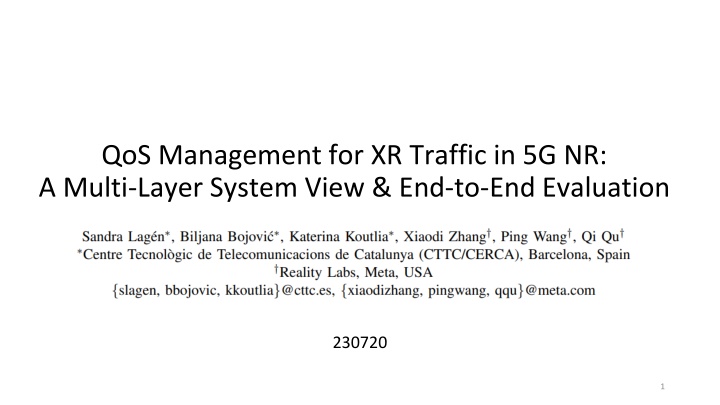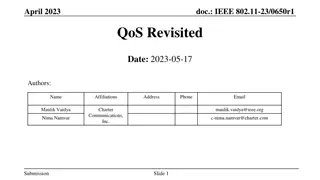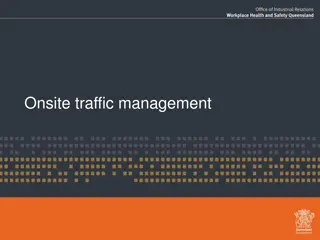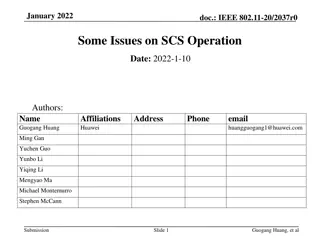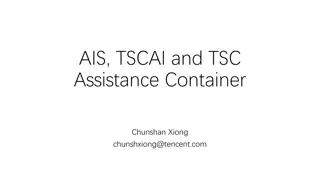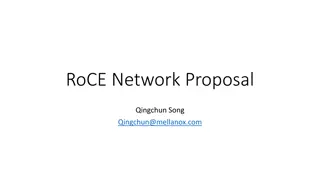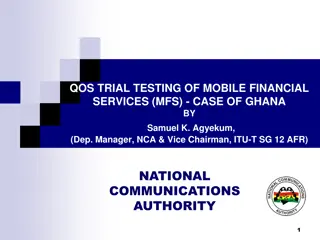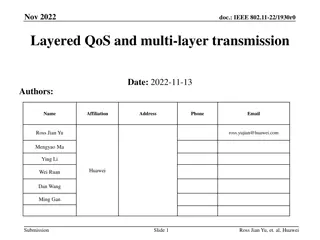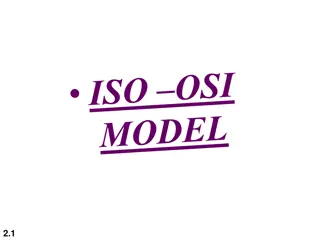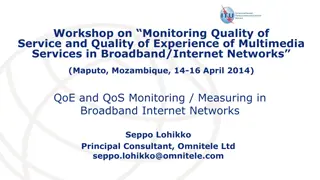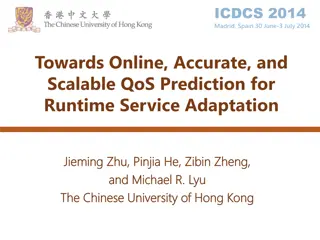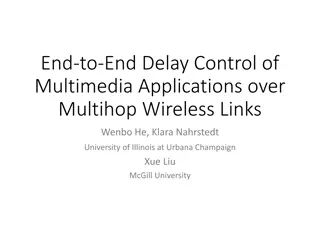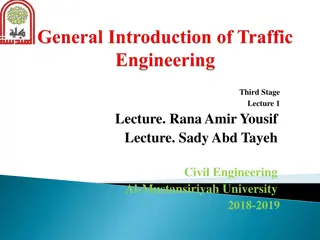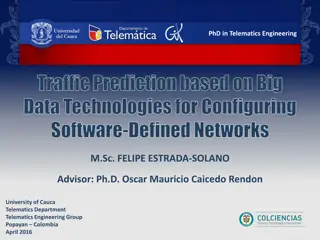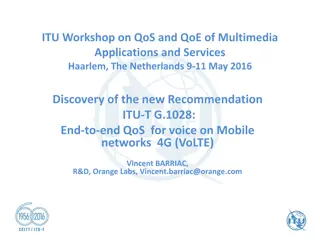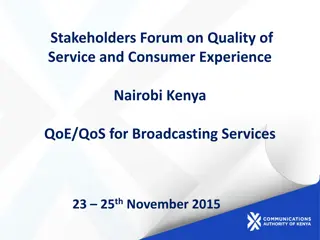5G NR Traffic QoS Management: Multi-Layer System View & End-to-End Evaluation
5G NR technology emphasizes enhanced QoS for XR traffic, including AR, VR, and Cloud Gaming. This research delves into handling QoS for XR/CG traffic at various layers, proposing QoS control mechanisms at the application and MAC layers, along with an evaluation of these approaches using a simulator. The architecture of 5G QoS involves a two-step mapping process for service data flows, with considerations for Core and Radio Access Networks. Additionally, the 5G QoS characteristics are outlined, including identifiers, resource types, priorities, delays, and error rates.
Download Presentation

Please find below an Image/Link to download the presentation.
The content on the website is provided AS IS for your information and personal use only. It may not be sold, licensed, or shared on other websites without obtaining consent from the author.If you encounter any issues during the download, it is possible that the publisher has removed the file from their server.
You are allowed to download the files provided on this website for personal or commercial use, subject to the condition that they are used lawfully. All files are the property of their respective owners.
The content on the website is provided AS IS for your information and personal use only. It may not be sold, licensed, or shared on other websites without obtaining consent from the author.
E N D
Presentation Transcript
QoS Management for XR Traffic in 5G NR: A Multi-Layer System View & End-to-End Evaluation 230720 1
Introduction 5G NR technology has been designed with enhanced QoS support The most important 5G media content: XR (including AR, VR), Cloud Gaming with stringent QoS requirements 5G Core Network and Radio Access Network must be specially designed to consider multiple service data flow with varying QoS requirements Contribution Review how to handle QoS for XR/CG traffics at different layers Propose a QoS control mechanism XR loopback at application layer Propose a QoS scheduler at MAC layer Conduct evaluation of proposed approaches using a simulator 2
5G QoS Architecture Two-step mapping process Service Data Flows 1. 5G Core Network (CN) maps SDFs to QoS flows (allow M:1 mappings) Data Radio Bearers 1. 5G Radio Access Network independently decides how to map QoS flows to DRBs (allow N:1 mappings) 3
5G QoS Characteristic 5G QoS Identifier (5QI) Resource type (GBR, non-GBR and delay-critical GBR) Priority level Packet delay Budget (PDB) Packet Error Rate (PER) Maximum data burst volume (for delay-criticcal GRB) Average window (for GRB and delay-critical GRB) 4
Input: packet loss/error, packet delay, received data rates, jitter Application Layer: XR Loopback Output: data rate, fps Video stream: a sequence of video frames arriving at the application layer according to a fixed video frame rate and a random jitter Two considered KPI (Key Performance Indicator): Data rate (mb/s) Frame generation rate (frames/s) Algorithm: if plr < 2% codec rate * 1.1; if plr > 10% codec rate / 2 5
UPF Layer: SDF to QoS Flow Mapping The UPF maps SDFs into suitable QoS flows through SDF/TFT templates. Mappings (SDF QoS flows) 1:1 M:1 User Plane Function (UPF) ex: In XR sessions, pose/control + audio/data + video/scene would go over the same flow They extend the simulator to support M:1 6
SDAP Layer: QoS Flow to DRB Mapping SDAP is a new layer introduced in 5G NR to map traffic from QoS flows to suitable DRBs Mappings (QoS flows DRBs) 1:1 Service Data Adaptation Protocol (SDAP) 1:1 M:1 Each DRB inherits 5QI from QoS flows M:1 N:1 1:1 Each DRB use configurable PDB and PER, and default priority level 7
RLC and PDCP Layers Each DRB is handled by a single PDCP entity The RLC and PDCP layers need to consider the QoS flow descriptions of the DRBs to properly configure RLC/PDCP entities discard timer at the RLC/PDCP transmit entity reordering window timer at the RLC/PDCP receiving entity Packet delay Budget Radio Link Control (RLC), Packet Data Convergence Protocol (PDCP) ex: For 5QIs with a PDB of 10ms, both the discard timer and the reordering window timer should be set to at most 10ms 8 They extend the simulator to support discard timer
MAC Layer: QoS Scheduler The MAC scheduler needs to consider the QoS flow descriptions of the active DRBs to perform the scheduling decisions The proposed QoS scheduler differs from traditional schedulers since it considers 5QIs and HOL simultaneously! (i.e. selecting the users to be scheduled and allocating physical resource blocks to them) w: indicates the priority for a DRB to be scheduled PF (Proportional Fair) ( = 1, assuming the same priority for all users and ignoring D) 9
PHY Layer The PHY layer does not have as much flexibility as higher layers for QoS control Some parameters can still be configured to address different traffic/flow types ex: suitable numerologies and their multiplexing can be properly selected to address latency-throughput trade-offs 10
ns-3 5G-LENA system-level simulator Experimental Setup Single-user Multi-user 1 base station + 16 users 4 users AR application (3 flows: video+audio / data+pose / control) 4 users VR application (1 video flow) 4 users Cloud Gaming (1 video flow) 4 users traditional VoIP M:1 mapping is adopted for AR at the UPF XR loopback adaptation applies to the video flows of all AR/VR/CG applications Transport protocol: UDP 11
one video flow for CG if plr < 2% codec rate * 1.1; Results: XR Loopback, Single-user if plr > 10% codec rate / 2 Initial codec rate: 5Mbps Max and min codec rate: 0.1 and 10 Mbps Packet losses arise as a result of the SINR variations Observations packet loss is very low Data rate Packet loss ratio the codec rate increases until its maximum value packet loss goes above 0.1 the codec rate quickly reduce, and it starts to recover when packet loss < 0.02 SINR (Signal-to-interference-plus-noise ratio) SINR = Signal Power / (Interference Power + Noise Power) 12
Results: XR Loopback + QoS scheduler, Multi-user XR loopback allows serving the maximum throughput for all flow types Without XR loopback, just the throughput of VoIP can be fully delivered XR loopback can make significant reduction of the end-to-end delays for AR, VR and CG, but not for VoIP Scenarios: 1. woLB-QoS 2. woLB-PF 3. wLB-QoS 4. wLB-PF XR loopback + QoS scheduler: all throughputs and delays are improved (except for CG delay, since CG is the lowest priority traffic) 13
Conclusion They review QoS architecture and QoS characterization in 5G NR They revisit various XR-aware QoS control strategies at different layers of the 5G NR protocol stack They introduce XR loopback mechanisms at the application layer and QoS schedulers at MAC layer for XR in 5G systems XR loopback and QoS scheduler optimize end-to-end performance The preliminary simulation shows the importance of cross-layer optimization between XR application and RAN 14
